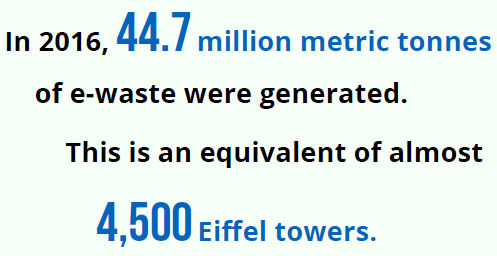More and more people are joining the global information society and digital economy, and are benefiting from the opportunities they offer. In parallel, higher levels of disposable incomes, urbanization, and industrialization in many developing countries are leading to growing amounts of electrical and electronic equipment and, consequently, to greater amounts of e-waste.
Discarded equipment, such as phones, laptops, fridges, sensors, and TVs contain substances that pose considerable environmental and health risks, especially if treated inadequately. Most e-waste is not properly documented and not treated through appropriate recycling chains and methods. At the same time e-waste streams challenge the efforts towards a circular economy as valuable and scarce resources are wasted.
NEW The Global E-waste Monitor 2017, a joint effort of the ITU, the United Nations University (UNU) and the International Solid Waste Association (ISWA), provides the most comprehensive overview of global e-waste statistics and an unprecedented level of detail, including an overview of the magnitude of the e-waste problem in different regions. The report includes up-to-date information on the amounts of e-waste generated and recycled, makes predictions until 2021, and provides information on the progress made in terms of e-waste legislation. The e-waste volumes are indicative of the recycling industry’s potential to recover secondary resources, as well as setting environmental targets for detoxification. The report highlights the need for better e-waste data and information for policymakers to track progress, identify the need for action, and to achieve sustainable development, including the Sustainable Development Goals (SDGs). 
DOWNLOAD THE GLOBAL E-WASTE MONITOR 2017 (PDF FORMAT)
- Full report
- Executive Summary
- Chapter 1 - What is E-waste?
- Chapter 2 - E-waste and Its Relation to the Sustainable Development Goals
- Chapter 3 - Information and Communication Technology (ICT) and EEE Consumption Trends
- Chapter 4 - Availability of International E-waste Statistics.
- Chapter 5 - Standards and Methodologies to Measure E-waste
- Chapter 6 - Global E-waste Status and Trends
- Chapter 7 - Transboundary Movement of E-waste
- Chapter 8 - Status of E-waste Legislations
- Chapter 9 - Urban Mining of E-waste
- Chapter 10 - Regional E-waste Status and Trends
- Annexes
Cap comentari:
Publica un comentari a l'entrada